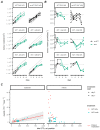Mathematical Modelling Based on In Vivo Imaging Suggests CD137-Stimulated Cytotoxic T Lymphocytes Exert Superior Tumour Control Due to an Enhanced Antimitotic Effect on Tumour Cells
- PMID: 34073822
- PMCID: PMC8197176
- DOI: 10.3390/cancers13112567
Mathematical Modelling Based on In Vivo Imaging Suggests CD137-Stimulated Cytotoxic T Lymphocytes Exert Superior Tumour Control Due to an Enhanced Antimitotic Effect on Tumour Cells
Abstract
Several immunotherapeutic strategies for the treatment of cancer are under development. Two prominent strategies are adoptive cell transfer (ACT) of CTLs and modulation of CTL function with immune checkpoint inhibitors or with costimulatory antibodies. Despite some success with these approaches, there remains a lack of detailed and quantitative descriptions of the events following CTL transfer and the impact of immunomodulation. Here, we have applied ordinary differential equation models to two photon imaging data derived from a B16F10 murine melanoma. Models were parameterised with data from two different treatment conditions: either ACT-only, or ACT with intratumoural costimulation using a CD137 targeted antibody. Model dynamics and best fitting parameters were compared, in order to assess the mode of action of the CTLs and examine how the CD137 antibody influenced their activities. We found that the cytolytic activity of the transferred CTLs was minimal without CD137 costimulation, and that the CD137 targeted antibody did not enhance the per-capita killing ability of the transferred CTLs. Instead, the results of our modelling study suggest that an antiproliferative effect of CTLs exerted upon the tumour likely accounted for the majority of the reduction in tumour growth after CTL transfer. Moreover, we found that CD137 most likely improved tumour control via enhancement of this antiproliferative effect, as well as prolonging the period in which CTLs were inside the tumour, leading to a sustained duration of their antitumour effects following CD137 stimulation.
Keywords: CD137; T cells; cytotoxic T lymphocytes; immunotherapy; mathematical modelling; ordinary differential equations; tumour.
Conflict of interest statement
The authors declare no conflict of interest.
Figures





Similar articles
-
In vitro stimulation and expansion of human tumour-reactive CD8+ cytotoxic T lymphocytes by anti-CD3/CD28/CD137 magnetic beads.Scand J Immunol. 2011 Aug;74(2):155-64. doi: 10.1111/j.1365-3083.2011.02564.x. Scand J Immunol. 2011. PMID: 21517928
-
Focusing and sustaining the antitumor CTL effector killer response by agonist anti-CD137 mAb.Proc Natl Acad Sci U S A. 2015 Jun 16;112(24):7551-6. doi: 10.1073/pnas.1506357112. Epub 2015 Jun 1. Proc Natl Acad Sci U S A. 2015. PMID: 26034288 Free PMC article.
-
Targeting spatiotemporal expression of CD137 on tumor-infiltrating cytotoxic T lymphocytes as a novel strategy for agonistic antibody therapy.J Immunother. 2012 Jul;35(6):460-72. doi: 10.1097/CJI.0b013e31826092db. J Immunother. 2012. PMID: 22735804
-
Deciphering CD137 (4-1BB) signaling in T-cell costimulation for translation into successful cancer immunotherapy.Eur J Immunol. 2016 Mar;46(3):513-22. doi: 10.1002/eji.201445388. Epub 2016 Feb 9. Eur J Immunol. 2016. PMID: 26773716 Review.
-
Rationale for anti-CD137 cancer immunotherapy.Eur J Cancer. 2016 Feb;54:112-119. doi: 10.1016/j.ejca.2015.09.026. Epub 2016 Jan 2. Eur J Cancer. 2016. PMID: 26751393 Review.
Cited by
-
Mathematical modeling identifies LAG3 and HAVCR2 as biomarkers of T cell exhaustion in melanoma.iScience. 2023 Apr 13;26(5):106666. doi: 10.1016/j.isci.2023.106666. eCollection 2023 May 19. iScience. 2023. PMID: 37182110 Free PMC article.
References
Grants and funding
LinkOut - more resources
Full Text Sources
Research Materials

